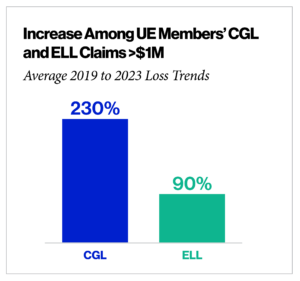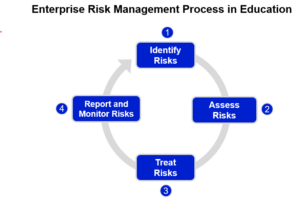
Opinions expressed in AGB blogs are those of the authors and not necessarily those of the institutions that employ them or of AGB.
As a trustee, your fiduciary duties to your college extend to the financial outcomes of lawsuits and settlements. In some cases, a community college trustee may even be personally liable for their college’s actions or negligence.
At United Educators (UE), an education-owned liability insurance carrier, we’ve helped colleges manage and insure liability risks since our founding in 1987.
Focus on the Changing Liability Risk Landscape
In recent years, issues of social inflation (the increase in insurer costs above general economic inflation) and other societal factors have drastically increased the cost of claims in higher education. From 2019 to 2023, the average size of primary general liability (CGL) and educators legal liability (ELL) claims—liability claims related to injury and wrongful acts—greater than $1 million increased 230 percent and 90 percent, respectively.

Community colleges, with their unique missions, operations, and academic portfolios, face nuances in their risks relative to their four-year counterparts. Because of the increasing cost of claims, it is important for your board of trustees to monitor how your college manages liability risk.
Oversee Risk Management
Your board of trustees should focus your college’s senior leadership on risk management. Many trustees instinctively turn toward strategic and financial risks, which is understandable given their role as fiduciaries. But don’t forget about liability risks. Numerous small claims or a few large ones can damage your college’s ability to achieve its mission.
We describe an effective board’s risk management approach as “noses in, fingers out.” A “noses in, fingers out” board emphasizes the importance of managing risk, asks questions about leadership’s approach to risk management, ensures the college has adequate insurance coverage, and holds leadership accountable for progress on risk management while respecting leadership’s role in implementing risk management protocols and processes.
Operationally, this can take on differing levels of maturity.
At the lower end of risk management maturity, a college’s audit committee will ask senior leadership to create a short list of critical risks and report on ongoing risk mitigation. A board committee—often the executive, audit, or finance committee—will oversee leadership’s management of the insurance portfolio to ensure the college has adequate coverage.

Boards overseeing a sophisticated risk management approach will ask senior leadership to implement an enterprise risk management (ERM) program. We advocate that colleges use a four-step ERM approach that combines quantitative and qualitative data to develop risk treatment and monitoring plans.
Regardless of the complexity of risk management at your college, pay attention to how the industry-wide liability risks facing all of education affect your college’s mission and context.
Critical and Emerging Liability Risks for Community Colleges
While every risk profile differs, some risks present urgent challenges. Ask your college’s senior leaders how they’re managing these six critical and emerging liability risks:
Abuse of Minors
Abuse of minors, in addition to the human tragedy, can lead to massive financial losses. It can happen—and has happened—at all kinds of colleges.
Community colleges may be more exposed to this risk than many four-year institutions because of their integration into local K–12 systems through dual enrollment, summer camps, and other community programs. Some community colleges have more minors than adult students on campus each year, yet they often dedicate few resources to youth protection.
Workplace Discrimination
Workplace discrimination, unfortunately, is frequent and can lead to costly claims. No college is immune. In addition to sound human resources practices, organizational culture and effective training play a large role in helping prevent discrimination.
Building a consistent culture and keeping up with training can be challenging for community colleges. Many have large populations of contingent faculty who bring norms and expectations from other industries, while employee turnover makes screening and training new employees an ongoing task. Faculty and staff unfamiliar with the college’s expectations may be prone to discriminate and retaliate against their colleagues.
Artificial Intelligence
Since ChatGPT’s launch in 2022, colleges have tried to manage the academic use of artificial intelligence (AI) in the classroom. Yet AI also carries emerging operational opportunities and risks. For example, AI applications have been known to discriminate, disclose private data, or use copyrighted materials. A recent AGB blog post, “Aligning and Governing AI to Leverage Resources and Enhance Results,” offers questions to help your AI oversight.
Freedom of Expression
The public and policymakers traditionally see community colleges as a more politically neutral part of the local community than their four-year counterparts. For example, community colleges have mostly avoided investigations from the Department of Education’s Office for Civil Rights on shared ancestry. However, that’s no reason to think community colleges are unaffected by issues related to freedom of expression. College leadership must take care to implement and follow freedom of expression policies that protect students’ rights while also protecting students from discrimination, especially as the upcoming elections intensify.
Lab, Studio, and Workshop Safety
While many community colleges successfully minimize the number of lab, studio, and workshop injuries, isolated incidents can lead to significant losses. For example, a four-year university might hire an environmental health and safety manager with expertise in science labs. Yet community colleges often rely on the decentralized expertise of their academic departments to monitor safety in disparate places, such as automotive workshops or chemistry labs. If the faculty or staff member responsible for safety in a lab or workshop forgets their duty or is on an extended absence, and no one notices, serious safety lapses and injuries can occur.
Hiring and Retaining Talented Staff
The struggle to hire and retain talented staff isn’t unique to community colleges. However, they may find it even more difficult to recruit from a shrinking local workforce and compete with the salaries of local industries.
Insufficient staffing can have a big, and often indirect, impact on liability. Employees stretched too thin might take shortcuts to compensate for vacancies on their teams. This can lead them to skirt around risk management protocols, forget to document allegations or investigations, and overlook safety issues. What may seem like a small shortcut can lead to an allegation of negligence following a major incident.
Justin Kollinger is a senior risk management consultant at United Educators and co-author of Risk Management: An Accountability Guide for University and College Boards (AGB, 2020).
United Educators Resource: “Steps to Help Control Your Legal Costs” (This United Educators article is available to all website visitors.)
With Thanks to AGB Event Sponsor: United Educators



